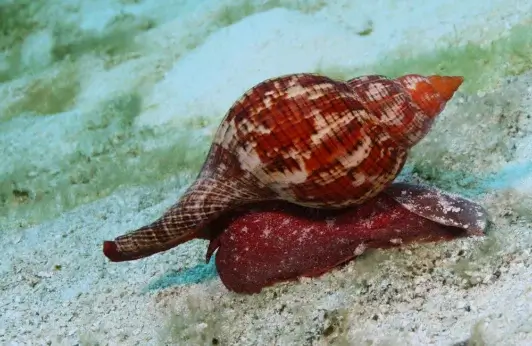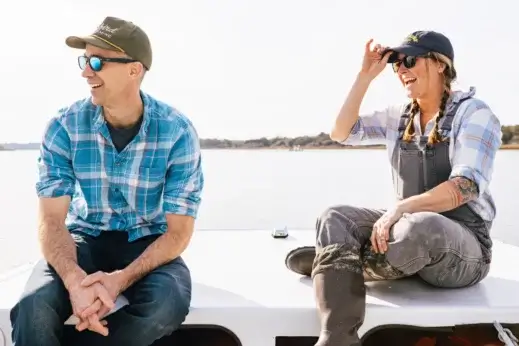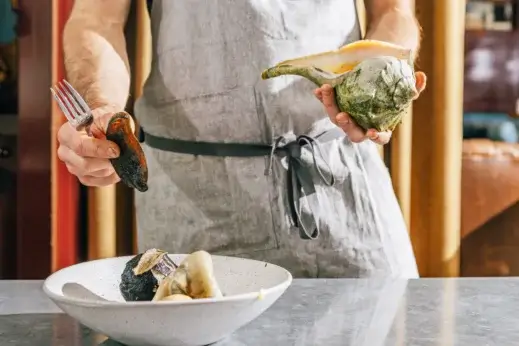Meet the Modern Chef and Forager Duo Bringing Snails to the Menu
At Seabird, a North Carolina restaurant, a chef and forager are showing diners how seasonal eating applies to seafood.
Meet the Modern Chef and Forager Duo Bringing Snails to the Menu
At Seabird, a North Carolina restaurant, a chef and forager are showing diners how seasonal eating applies to seafood.

Dean Neff and Ana Shellem on the water. by Baxter Miller
They are large for snails, with fully grown shells reaching up to nearly 10 inches. And they’re pretty. Their shells are often splotched with red or orange markings or deep amber striping curving along the tip. But more importantly, they are delicious, simmered with aromatics and served with a light seaweed over a bed of pasta.
They are tulip snails, a mollusk found in the sandy bottoms of shallow pools along the south eastern coast of the US. And while they may not be the typical fare you expect at a swanky seafood restaurant in the US, at Seabird, they sit proudly alongside menu classics such as crab, yellowfin tuna and oysters.

Seabird, in Wilmington, NC, is a sustainable seafood place that utilizes foraging to get many of its ingredients—and to act as an opportunity for education. Rather than rely only on farmed fish or wild caught fish that is shipped from ports across the world, Neff tries to work with local food, which can create a bit of uncertainty in the menu. Ordering 50 pounds of swordfish from a distributor is a fairly straightforward process. But with local fishing and foraging, you’re working with a wild population, and you’re not guaranteed to find what you set out for. You’re also limited by the seasonality of the food.
“I think everybody knows that tomatoes or okra or cabbages are seasonal,” says chef and owner Dean Neff. “But I don’t know that everyone knows the seasonality of oysters or speckled sea trout. Being able to have conversations about that and about sustainability with seafood was important to us.”
Read More
Meet the coastal farm and forager introducing Oregon to climate cuisine.
Neff opened the restaurant in 2021 with his partner, and he started working with foragers to access local ingredients at sustainable levels. That’s when he met Ana Shellem of Shell’em Seafood, a coastal forager and sustainable fisher who works along the coastline of Masonboro Island. Shellem began foraging five years ago, after many years of harvesting wild shellfish. As a conservationist, Shellem is careful when and where she harvests, only bringing in what is in season and in small quantities. “When you eat wild and in season…I only eat oysters in season, even though with farmed oysters, you can eat them year round. But I think everything is at its finest when it’s in season. Eating a tomato in the winter is not as exciting as eating a tomato in the summer and appreciating the flavor profiles.”

Most shellfish seasons have to do with their cycle of breeding and molting, normally coinciding with water temperature. For instance, stone crabs along the east coast are out of season in the summer months, when the crabs will molt, shedding their shells and pumping the warm sea water in and out of their bodies to create new exoskeletons. It’s when the crabs have shed their shells that they can mate, creating nests for their egg sacs. That mating and molting will be done by October, and the season will pick up again then. It’s similar for lobsters. Over the summer, lobsters will migrate into warmer, shallower water to feed and molt, which makes them easier to catch. However, a lobster without its hard shell is trickier to transport, so the peak of lobster season is often earlier in the springtime or in December, before the waters get too cold.
Take action
Make a commitment to seasonal eating with this seasonal food guide.
Each organism in the ocean, just like on land, has a season of rest, regrowth, or stasis, followed by a season of abundance. As consumers, we’re often used to eating strawberries in January or oysters in June. But to truly be aligned with seasonality, Shellem and Neff say, is to widen your palate and embrace other options.
“It’s amazing to work with James Beard chefs that are educated and able to experiment with obscure things, like the tulip snails that Dean’s been working with, or North Carolina whelks. The seaweeds I get to bring him are really fun, like the sea bean or prickly pear cactus,” says Shellem. “I’ll even drop off samples so they can make a staff meal, just to educate their staff as well. It is so much fun to see so many people so passionate about the same thing with the same goal.”
But here’s where it gets tricky. Eating seasonally or prioritizing local foods is not just about trying new things. It’s also about learning what the limitations are and sometimes, living with disappointment. Foragers on land, for instance, will only take a certain number of mushrooms in a patch, to ensure sufficient regrowth. For Shellem, the same principle applies to seafood. She gathers what she needs for her restaurants and leaves the rest to flourish. That can make for an uncomfortable conversation at the dinner table. “When we were first opening, we explained to the servers that we’re going to run out of a particular fish tonight, and for some people that gives them anxiety,” says Neff. “But I think that should make you happy. Because that’s the nature of a sustainable restaurant; supplies are limited. We will be constantly changing.” For Neff, leaning into that change, and getting his customers used to it, is key.
Learn more:
Curious about the seafood and aquatic habitat in your region?
For Shellem, the lesson is more blunt but arguably more widely applicable. “I think if people could be more comfortable with being told ‘no’ sometimes, that would be awesome.”

As for the tulip snails, Neff says they’ve been popular, and they’ve even had customers come in specifically looking for the snails. “We had people come all the way from France, not too long ago, and they said their main agenda was to eat at the restaurant,” which Neff concedes is a lot of pressure on one dinner order. However, it also means his message is spreading. “It meant so much to them to try [an ingredient] so unique that they’ve never had before.”
Follow us
This work is licensed under a Creative Commons Attribution-NoDerivatives 4.0 International License.
Want to republish a Modern Farmer story?
We are happy for Modern Farmer stories to be shared, and encourage you to republish our articles for your audience. When doing so, we ask that you follow these guidelines:
Please credit us and our writers
For the author byline, please use “Author Name, Modern Farmer.” At the top of our stories, if on the web, please include this text and link: “This story was originally published by Modern Farmer.”
Please make sure to include a link back to either our home page or the article URL.
At the bottom of the story, please include the following text:
“Modern Farmer is a nonprofit initiative dedicated to raising awareness and catalyzing action at the intersection of food, agriculture, and society. Read more at <link>Modern Farmer</link>.”
Use our widget
We’d like to be able to track our stories, so we ask that if you republish our content, you do so using our widget (located on the left hand side of the article). The HTML code has a built-in tracker that tells us the data and domain where the story was published, as well as view counts.
Check the image requirements
It’s your responsibility to confirm you're licensed to republish images in our articles. Some images, such as those from commercial providers, don't allow their images to be republished without permission or payment. Copyright terms are generally listed in the image caption and attribution. You are welcome to omit our images or substitute with your own. Charts and interactive graphics follow the same rules.
Don’t change too much. Or, ask us first.
Articles must be republished in their entirety. It’s okay to change references to time (“today” to “yesterday”) or location (“Iowa City, IA” to “here”). But please keep everything else the same.
If you feel strongly that a more material edit needs to be made, get in touch with us at [email protected]. We’re happy to discuss it with the original author, but we must have prior approval for changes before publication.
Special cases
Extracts. You may run the first few lines or paragraphs of the article and then say: “Read the full article at Modern Farmer” with a link back to the original article.
Quotes. You may quote authors provided you include a link back to the article URL.
Translations. These require writer approval. To inquire about translation of a Modern Farmer article, contact us at [email protected]
Signed consent / copyright release forms. These are not required, provided you are following these guidelines.
Print. Articles can be republished in print under these same rules, with the exception that you do not need to include the links.
Tag us
When sharing the story on social media, please tag us using the following: - Twitter (@ModFarm) - Facebook (@ModernFarmerMedia) - Instagram (@modfarm)
Use our content respectfully
Modern Farmer is a nonprofit and as such we share our content for free and in good faith in order to reach new audiences. Respectfully,
No selling ads against our stories. It’s okay to put our stories on pages with ads.
Don’t republish our material wholesale, or automatically; you need to select stories to be republished individually.
You have no rights to sell, license, syndicate, or otherwise represent yourself as the authorized owner of our material to any third parties. This means that you cannot actively publish or submit our work for syndication to third party platforms or apps like Apple News or Google News. We understand that publishers cannot fully control when certain third parties automatically summarize or crawl content from publishers’ own sites.
Keep in touch
We want to hear from you if you love Modern Farmer content, have a collaboration idea, or anything else to share. As a nonprofit outlet, we work in service of our community and are always open to comments, feedback, and ideas. Contact us at [email protected].by Emily Baron Cadloff, Modern Farmer
August 6, 2024
Modern Farmer Weekly
Solutions Hub
Innovations, ideas and inspiration. Actionable solutions for a resilient food system.
ExploreExplore other topics
Share With Us
We want to hear from Modern Farmer readers who have thoughtful commentary, actionable solutions, or helpful ideas to share.
SubmitNecessary cookies are absolutely essential for the website to function properly. This category only includes cookies that ensures basic functionalities and security features of the website. These cookies do not store any personal information.
Any cookies that may not be particularly necessary for the website to function and are used specifically to collect user personal data via analytics, ads, other embedded contents are termed as non-necessary cookies.
Can tulip snails grow at home commercially?